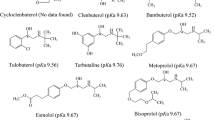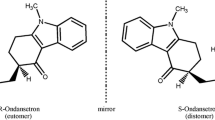Abstract
This study aimed to develop and validate a high-performance liquid chromatography system combined with a single-quadrupole Dalton mass detector for the separation and determination of pidotimod ((R)-3-[(S)-(5-oxo-2-pyrrolidinyl)carbonyl]-thiazolidine-4-carboxylic acid) and its three isomers. The separations were achieved using a Lux Amylose-1 column operated at 40 °C using acetonitrile/0.1% trifluoroacetate (TFA) and isopropanol/0.1% TFA (90:10, v/v). The enantiorecognition mechanism was also elucidated using the ORCA 5 program. Four isomers were successfully separated with a resolution (Rs) > 1.5, with the method showing satisfactory linearity in the ranges of 0.2 to 3.5 μg·mL−1 (S,R; S,S) and 0.5 to 3.5 μg·mL−1 (R,S; R,R), along with good specificity, accuracy, and precision. Further, three batches of pidotimod oral solutions were evaluated and the S,S-isomer in each batch was detected at about 0.05%. Moreover, computational evaluations suggested that the sorbent-analyte interactions of amylose tris(3,5-dimethylphenycarbamate) can be used to successfully interpret and even predict the chromatographic separation results. The validated method showed high sensitivity and can potentially be used to analyze the isomer impurities of raw materials for quality control purposes.





Similar content being viewed by others
References
Nguyen LA, He H, Pham-Huy C (2006) Chiral drugs: an overview. Int J Biomed Sci 2:85–100
Stalcup AM (2010) Chiral separations. Annu Rev Anal Chem 3:341–363. https://doi.org/10.1146/annurev.anchem.111808.073635
Okamoto Y, Ikai T (2008) Chiral HPLC for efficient resolution of enantiomers. Chem Soc Rev 37:2593–2608. https://doi.org/10.1039/B808881K
Okamoto Y, Kawashima M, Hatada K (1986) Chromatographic resolution. XI, J Chromatogr A 363:173–186. https://doi.org/10.1016/S0021-9673(01)83736-5
Okamoto Y, Yashima E (1998) Polysaccharide derivatives for chromatographic separation of enantiomers. Angew Chem Int Ed Engl 37:1020–1043
Peluso P, Sechi B, Lai G, Dessì A, Dallocchio R, Cossu S, Aubert E, Weiss R, Pale P, Mamane V, Chankvetadze B (2020) Comparative enantioseparation of chiral 4,4′-bipyridine derivatives on coated and immobilized amylose-based chiral stationary phases. J Chromatogr A 1625:461303. https://doi.org/10.1016/j.chroma.2020.461303
Chankvetadze B (2019) Polysaccharide-based chiral stationary phases for enantioseparations by high-performance liquid chromatography: an overview. Methods Mol Biol 1985:93–126. https://doi.org/10.1007/978-1-4939-9438-0_6
Kasat RB, Zvinevich Y, Hillhouse HW, Thomson KT, Wang N-HL, Franses EI (2006) Direct probing of sorbent-solvent interactions for amylose Tris(3,5-dimethylphenylcarbamate) using infrared spectroscopy, X-ray diffraction, solid-state NMR, and DFT modeling. J Phys Chem B 110:14114–14122. https://doi.org/10.1021/jp061892d
Kasat RB, Wee SY, Loh JX, Wang NH, Franses EI (2008) Effect of the solute molecular structure on its enantioresolution on cellulose tris(3,5-dimethylphenylcarbamate). J Chromatogr B 875:81–92. https://doi.org/10.1016/j.jchromb.2008.06.045
Ferrario BE, Garuti S, Braido F, Canonica GW (2015) Pidotimod: the state of art. Clin Mol Allergy 13:8. https://doi.org/10.1186/s12948-015-0012-1
Magni A, Signorelli G, Bocchiola G (1994) Synthesis and preliminary pharmacological evaluation of pidotimod, its enantiomer, diastereomers and carboxamido derivatives. Arzneim Forsch 44:1402–1404. https://doi.org/10.1002/chin.199524213
Dou X, Su X, Wang Y, Chen Y, Shen W (2015) Studies on pidotimod enantiomers with Chiralpak-IA: crystal structure, thermodynamic parameters and molecular docking. Chirality 27:802–808. https://doi.org/10.1002/chir.22493
Neese F (2012) The ORCA program system. WIREs Comput Mol Sci 2:73–78. https://doi.org/10.1002/wcms.81
Lu T, Chen F (2012) Multiwfn: a multifunctional wavefunction analyzer. J Comput Chem 33:580–592. https://doi.org/10.1002/jcc.22885
Perdew JP, Burke K, Wang Y (1996) Generalized gradient approximation for the exchange-correlation hole of a many-electron system. Phys Rev B Condens Matter 54:16533–16539. https://doi.org/10.1103/physrevb.54.16533
Grimme S, Antony J, Ehrlich S, Krieg H (2010) A consistent and accurate ab initio parametrization of density functional dispersion correction (DFT-D) for the 94 elements H-Pu. J Chem Phys 132:154104. https://doi.org/10.1063/1.3382344
Morrow TI, Maginn EJ (2002) Molecular Dynamics study of the ionic liquid 1-n-butyl-3-methylimidazolium hexafluorophosphate. J Phys Chem B 106:12807–12813. https://doi.org/10.1021/jp0267003
Jansen HB, Ros P (1969) Non-empirical molecular orbital calculations on the protonation of carbon monoxide. Chem Phys Lett 3:140–143. https://doi.org/10.1016/0009-2614(69)80118-1
Boys SF, Bernardi F (1970) The calculation of small molecular interactions by the differences of separate total energies. Some procedures with reduced errors. Mol Phys 19:553–566. https://doi.org/10.1080/00268977000101561
van Duijneveldt FB, van Duijneveldt JG, van de Rijdt CM, van Lenthe JH (1994) Chem Rev 94:1873
Chankvetadze B, Kartozia I, Yamamoto C, Okamoto Y (2002) Comparative enantioseparation of selected chiral drugs on four different polysaccharide-type chiral stationary phases using polar organic mobile phases. J Pharm Biomed Anal 27:467–478. https://doi.org/10.1016/s0731-7085(01)00648-3
Matarashvili I, Chelidze A, Dolidze G, Kobidze G, Zaqashvili N, Dadianidze A, Bacskay I, Felinger A, Farkas T, Chankvetadze B (2020) Separation of enantiomers of chiral basic drugs with amylose- and cellulose- phenylcarbamate-based chiral columns in acetonitrile and aqueous-acetonitrile in high-performance liquid chromatography with a focus on substituent electron-donor and electron-acceptor effects. J Chromatogr A 1624:461218. https://doi.org/10.1016/j.chroma.2020.461218
Lv C, Jia G, Zhu W, Qiu J, Wang X, Zhou Z (2007) Enantiomeric resolution of new triazole compounds by high-performance liquid chromatography. J Sep Sci 30:344–351. https://doi.org/10.1002/jssc.200600282
Crimella T, Orlandi R, Bocchiola G, Anders U, Stradi R (1994) Analytical and chemical profile of pidotimod. Arzneim Forsch 44:1405–1410
Caccamese S, Bianca S, Carter GT (2009) Direct high-performance liquid chromatographic separation of the enantiomers of venlafaxine and 11 analogs using amylose-derived chiral stationary phases. Chirality 21:569–577. https://doi.org/10.1002/chir.20633
Chinese Pharmacopoeia Committee (2020) Pharmacopoeia of People’s Republic of China. Part 4. Chemical Industry Press, Beijing, pp 480–483
Ghanem A (2007) Exploring solvent versatility in immobilized cellulose-based chiral stationary phase for the enantioselective liquid chromatographic resolution of racemates. J Sep Sci 30:1019–1028. https://doi.org/10.1002/jssc.200600357
Hamman C, Wong M, Hayes M, Gibbons P (2011) A high throughput approach to purifying chiral molecules using 3 μm analytical chiral stationary phases via supercritical fluid chromatography. J Chromatogr A 1218:3529–3536. https://doi.org/10.1016/j.chroma.2011.03.066
Funding
This work was supported by 2021 Project of Key Laboratory of Chemical Quality Research and Evaluation, Grant/Award Number: 1030050090128.
Author information
Authors and Affiliations
Contributions
All the authors contributed to the study conception and design. Material preparation, data collection, and analysis of HPLC-Qda were performed by CZ. WL performed the DFT calculations and analysis. The first draft was written by CZ and all the authors commented on previous versions of the manuscript. All the authors have read and approved the final manuscript. Conceptualization: CZ; methodology: CZ; formal analysis and investigation: CZ and WL; writing—original draft preparation: CZ; writing—review and editing: CZ; funding acquisition: CZ; resources: CZ, WL, and BN; supervision and project administration: BN.
Corresponding author
Ethics declarations
Conflict of Interest
The authors declare that they have no known competing financial interests or personal relationships that could have appeared to influence the work reported in this paper.
Additional information
Publisher's Note
Springer Nature remains neutral with regard to jurisdictional claims in published maps and institutional affiliations.
Rights and permissions
Springer Nature or its licensor (e.g. a society or other partner) holds exclusive rights to this article under a publishing agreement with the author(s) or other rightsholder(s); author self-archiving of the accepted manuscript version of this article is solely governed by the terms of such publishing agreement and applicable law.
About this article
Cite this article
Zhang, C., Li, W. & Ning, B. Enantiomeric Resolution of Pidotimod and Its Isomers in Pidotimod Oral Solutions Using Chiral RP-HPLC with Quadrupole Dalton Analyzer Detection. Chromatographia 86, 55–62 (2023). https://doi.org/10.1007/s10337-022-04224-1
Received:
Revised:
Accepted:
Published:
Issue Date:
DOI: https://doi.org/10.1007/s10337-022-04224-1




